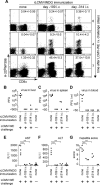Envelope exchange for the generation of live-attenuated arenavirus vaccines
- PMID: 16751848
- PMCID: PMC1472708
- DOI: 10.1371/journal.ppat.0020051
Envelope exchange for the generation of live-attenuated arenavirus vaccines
Abstract
Arenaviruses such as Lassa fever virus cause significant mortality in endemic areas and represent potential bioterrorist weapons. The occurrence of arenaviral hemorrhagic fevers is largely confined to Third World countries with a limited medical infrastructure, and therefore live-attenuated vaccines have long been sought as a method of choice for prevention. Yet their rational design and engineering have been thwarted by technical limitations. In addition, viral genes had not been identified that are needed to cause disease but can be deleted or substituted to generate live-attenuated vaccine strains. Lymphocytic choriomeningitis virus, the prototype arenavirus, induces cell-mediated immunity against Lassa fever virus, but its safety for humans is unclear and untested. Using this virus model, we have developed the necessary methodology to efficiently modify arenavirus genomes and have exploited these techniques to identify an arenaviral Achilles' heel suitable for targeting in vaccine design. Reverse genetic exchange of the viral glycoprotein for foreign glycoproteins created attenuated vaccine strains that remained viable although unable to cause disease in infected mice. This phenotype remained stable even after extensive propagation in immunodeficient hosts. Nevertheless, the engineered viruses induced T cell-mediated immunity protecting against overwhelming systemic infection and severe liver disease upon wild-type virus challenge. Protection was established within 3 to 7 d after immunization and lasted for approximately 300 d. The identification of an arenaviral Achilles' heel demonstrates that the reverse genetic engineering of live-attenuated arenavirus vaccines is feasible. Moreover, our findings offer lymphocytic choriomeningitis virus or other arenaviruses expressing foreign glycoproteins as promising live-attenuated arenavirus vaccine candidates.
Conflict of interest statement
Figures





References
-
- Buchmeier MJ, Bowen MD, Peters CJ. Arenaviridae: The viruses and their replication. In Knipe DM, editor. Fields Virology. Philadelphia: Lippincott Williams & Wilkins; 2001. pp. 1635–1668.
-
- McCormick JB, Webb PA, Krebs JW, Johnson KM, Smith ES. A prospective study of the epidemiology and ecology of Lassa fever. J Infect Dis. 1987;155:437–444. - PubMed
-
- Borio L, Inglesby T, Peters CJ, Schmaljohn AL, Hughes JM, et al. Hemorrhagic fever viruses as biological weapons: Medical and public health management. JAMA. 2002;287:2391–2405. - PubMed
-
- Charrel RN, de Lamballerie X. Arenaviruses other than Lassa virus. Antiviral Res. 2003;57:89–100. - PubMed
Publication types
MeSH terms
Substances
LinkOut - more resources
Full Text Sources
Other Literature Sources

